The Soviet Union: Work and retirement
[Part of the Soviet Union series]
The Soviet Constitution said
ARTICLE 119. Citizens of the U.S.S.R. have the right to rest and leisure. The right to rest and leisure is ensured by the reduction of the working day to seven hours for the overwhelming majority of the workers, the institution of annual vacations with full pay for workers and employees and the provision of a wide network of sanatoria, rest homes and clubs for the accommodation of the working people. (Soviet Constitution 1936)
Article 41. Citizens of the USSR have the right to rest and leisure. This right is ensured by the establishment of a working week not exceeding 41 hours, for workers and other employees, a shorter working day in a number of trades and industries, and shorter hours for night work; by the provision of paid annual holidays, weekly days of rest, extension of the network of cultural, educational, and health-building institutions, and the development on a mass scale of sport, physical culture, and camping and tourism; by the provision of neighborhood recreational facilities, and of other opportunities for rational use of free time.The length of collective farmers' working and leisure time is established by their collective farms. (Soviet Constitution 1977)
And what did Soviet workers actually get?
According to one International Labor Organization report (1994), pre-revolutionary Russian workers worked 10-12 hours per day, six days a week. That's a lot: 60-72 hours per week. After the Revolution, a 8 hour/day week (but six days per week) was imposed. Then, they wanted to transition to a 7 hour/day week, and such a transition was made between 1927-1933. Still, this was a six day week: average hours worked were 40.3 per week.
In 1929, the transition to a 5-day week was decreed, but it rose back to eight hours a day, 6-days a week just before World War II. After the war, it went down to seven hours (1956-1960), but was still six days a week. This agrees with a CIA report (1961).
 Source: ILO report
Source: ILO report
Then, in 1961-1967, they switched to 5 days per week, 8 hours per day, which finally gave the Soviets a real weekend, like those in the West. Bronson (1968) sees this as an abandonment of Soviet commitment to continuously reduce the workday and workweek, and overall agrees with the ILO report. He also mentions that there were night shifts. In the textile industry, 60% of people worked at night at some point by 1960.
In 1966, a 35-hour working week was proposed. This would be 6-hours per day, 6 days per week or 7 hours per day, 5 days per week. But this was never implemented.
In 1987, the maximum number of hours was limited to 40 per week, with more in some sectors (agriculture, construction, transport), and less in others (education, art and culture, or coal mining)
 Source: ILO report
Source: ILO report
Soviets had 15 minimum days of paid holidays per week by then and 75% of workers had more than that. Workers younger than 18 were entitled to twice that. Working mothers with more than two children and less than 28 days of holidays per year, had three more days of holidays. Additionally, women had partial paid leave for infant care (<1 year), and they could take additional unpaid leave (<18 months)
 Source: ILO report
Source: ILO report
Regarding retirement, women retired at 55, and men retired at 60. The average pension was small, 86 roubles for workers, and 54 for collective farmers. Minimum pensions were 50% of the wages.
A second source is William Moskoff's Labour and Leisure in the Soviet Union (1984).
He mentions a couple of points regarding Soviet workers: the levels of absenteeism were twice as high as in the US. There were lots of 'auxiliary' workers (warehousing, transportation and repairing), 85 such workers per 100 production workers. In the US it was 38 to 100. There is, he says, shortage of labour in the Soviet Union, and that leisure in the SU wasn't as enjoyable as in the West:
The data that unfold in the course of this book do not testify to the abundant success of the Soviet system in meeting Marxist ideals. On the contrary, typical Soviet citizens are subject to substantial restrictions on their options during their free time. These restrictions reflect two elements within the society. First, the low priority given to the production of recreational and cultural goods. This is true of those leisure goods available on a day-to-day basis as well as facilities for holidays. Moreover, they reflect the relative inadequacies of the service sector.
But they also represent a philosophical perspective of the directors of the Soviet system. Work is still considered the most important category in the life of an individual. It is certainly viewed as more important than leisure. As one Soviet writer put it: 'material production and labour of a person comprises the basis of his development'. In the strictest sense the end of life is work and time off or leisure is for the purpose of getting ready for work again. One source uses the term pros toe vosproizvodstvo (simple reproduction) about non-working time during which other kind of work is being done, e.g. housework. There is much the same implication in the term rasshirennoe vosproizvodstvo (large-scale reproduction) which stands for free time or leisure time. 2 Free time is thus regarded as the time in which one regenerates for the real purpose oflife, which is work. [...]
At the 24th Communist Party Congress in 1971, First Secretary Leonid Brezhnev said, 'Free time is not time free from responsibility for the society'. The rather amorphous idea that the individual should make choices that accord with social values has been spelled out more recently: 'Individual development of a worker is connected above all with the effectiveness of socially useful activity. That is why the society requires of its members conscious submission of personal interests to social interests. This affirms not only the value of free time in all its richness, but also the value of human life ... What definite set of values finds its realisation in the activity of youth in free time? It is interested in definite orientation to basic social values of the society. And that defines the limits of possible activity of a young worker's leisure activity
He has data for average length of the workweek:
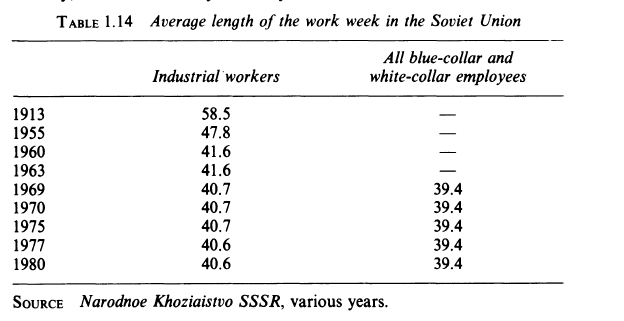 Source: Moskoff (1984)
Source: Moskoff (1984)
Malle (1990) adds some data: In 1987, hours were at 40.6.
Regarding pensioners, Moskoff says men had a right to pension at 60, and women at 55. People in harmful or dangerous occupations retired at 50-55 years for men, and 45-50 years for women. Some ensioners also worked to supplement their pensions:
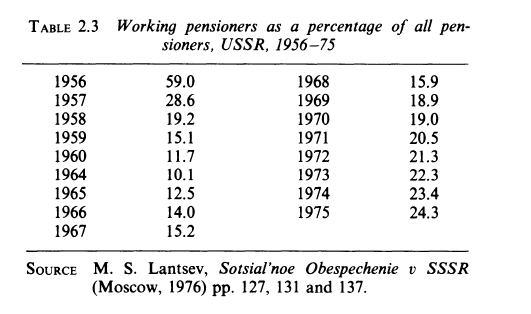 Source: Moskoff (1984)
Source: Moskoff (1984)
Collective farmers, however, did not public have old-age pensions until 1964. They retired 5 years later than in the state sector. Their minimum pension was 12 roubles (2/3 of 3800 pensioners in an study in Kalininskaia Oblast were paid this), and the maximu, 102. In 1971 they were raised to a minimum of 20 roubles. Compare to 45 roubles in the non-collective agriculture retirees. Collective farms supplemented this with their own funds.
Regarding overtime, according to Law, it wasn't supposed to be much used, the maximum was 120 hours per year. Overtime was allowed for: production for national defense and coping with natural disasters, keeping public utilities working, complete work that wasn't finished during the regular work time, to repair equipment if it being damaged would force a stop of the factory, and on assembly line work if the worker in the next shift didn't turn up. Overtime cannot be refused unless there's an official exemption: <18 year olds, pregnant women, nursing mothers, mothers with children <1 year, tuberculosis patients, and students.
Overtime was requested by factory mangers to the local trade union commitee, but in practise it was always granted. That is, state company management were relatively free to request overtime, and labour unions were weak.
The notion that overtime is considered to be the number of hours in excess of a given work day is deceptive. For the purpose of actually determining how much overtime pay has been earned, the accounting period is the month. The amount of overtime work is calculated in the following way. One takes the number of work days in a month, multiplies it by the number of hours in the normal work day of the individual and compares this figure with the number of hours actually worked. Anything above the first figure is considered overtime work.
This provides a great deal more flexibility for the Soviet employer, i.e. the state, than the typical American model where for workers covered by Federal legislation and most union contracts, overtime is anything over a 40 hour week. In the Soviet case, however, a worker could in fact work 8 hours over the norm during one week of the month, but if for some reason there is a work stoppage during another week and he works 8 hours under the norm, then from the point of view of compensation, no overtime needs to be paid. [...]
There is no extra premium for doing overtime work at night. This means that either workers do not differentiate between night and day, or there is coercion to get the work done because there is indeed a differencein tastes as regards day and night work.
Moskoff estimates estimates that in 1959, men worked 10.5 hours of overtime per month. This is all below the legal maximum of 120.
Regarding paid holidays, Moskoff offers us this table:
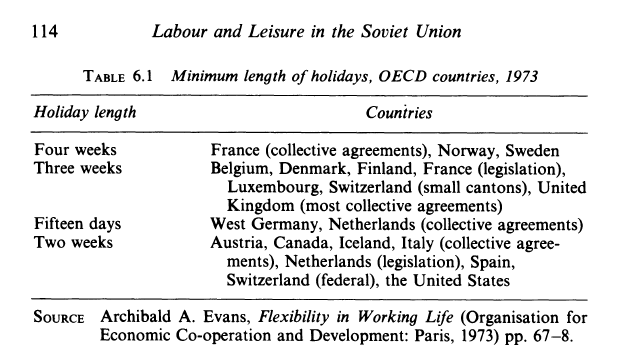 Source: Moskoff (1984)
Source: Moskoff (1984)
In the Soviet Union, the legal minimum was 15 days, but in both the SU and the OECD countries, the actual average was higher. In the SU, they were 18.5 days (1958) and 19.3 days (1964), and then 20.9 (1968) and 21.6 (1977) days.
According to Moskoff, the workers in half the OECD countries have more holidays than in the SU, while the rest have roughly the same.
Initially, Soviets had one month of holidays. This was reduced to 2 weeks in 1921. In 1941, holidays were eliminated due to World War II, but workers received extra compensation. In 1942, the extra compensation was eliminated too. In 1945, the 2 week holiday came back, and then you can go back to the ILO report.
Another source is Work, Employment, and Unemployment in the Soviet Union (Porket, 1989), but he focuses on unemployment -which, contrary to official data, existed-. But this is not the topic for this post.
We can compare the Soviet data with data from the West. Going by annual hours worked per year, the existence of the Soviet Union doesn't seem to have affected its reduction: That is, the idea that reduction in hours due to a heightened demands of workers because of the Soviet Union does not seem true.
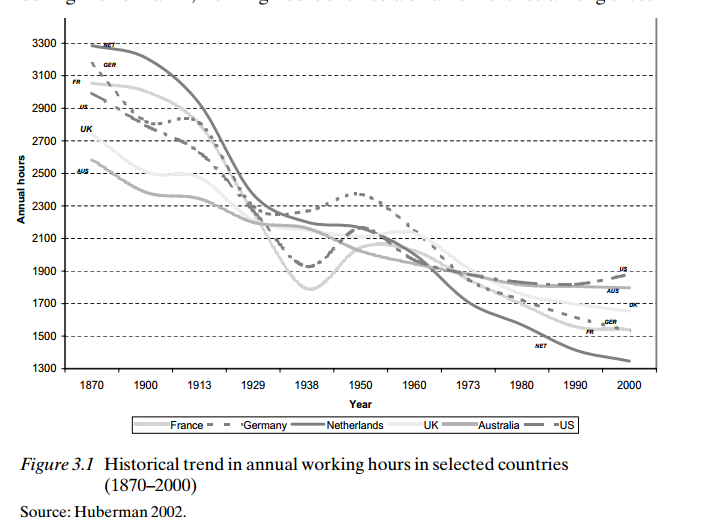 Source: Lee et al. (2007)
Source: Lee et al. (2007)
According to the previously cited ILO report, working time in the SU was set at 2040 hours per year in 1986. So Soviet workers were working 100 hours more than their counterparts in the West. Max Roser's excellent website also has some data for this, and also agrees that by 1986, no country in the West worked more than 2000 hours.
Self-fulfillment at work (Edit 26/02/17)
One of the promises of communism was to abolish the alienation of the worker. For Marx, work was seen as a very important part of a person's life, and he saw waged labour as breaking the link between one's work and the final product produced, which the worker isn't entitled to. Some modern day communists see many jobs in the current market economies as an example of this. They are sometimes referred to as 'bullshit jobs'. Meaningless, repetitive jobs that are pointed to as a failing of capitalism. That seems to forget, though, that even in utopia someone has to clean the floor and flip the burgers. The Soviet Union didn't pay workers for the value that they produced, but they seemed to pay them for how physically hard their work was.
According to Soviet ideology, the abolishment of privat e ownership of the means of production will put an end to the alienatio n of labor . At the same time, however, the Soviet Union does not dene y the fact that unpleasant working conditions exist in certain places . During the last 20 years, poor working conditions were seen as a transitory phenomenon that would disappear as a result of the imminen t scientific-technological revolution . In reality, Soviet workin g conditions leave much to be desired according to recent finding s inSoviet empirical sociology. (Johnson & Raynes (1984))
One of the goals of Soviet socialism was, in reference to the above, to instill in people a liking for the work they were doing, to remind them that now they were working for themselves, and that what they were producing was - a fraction of it - theirs. Turns out that it didn't work that well. Johnson and Raynes mention two official polls, conducted in 1960 and 1970 regarding attitudes towards work, and they could measure a change in attitude towards works, but in the opposite direction. That is, workers shifted in the direction of seeing work as a means for further goals rather than an end in itself, as Marxism would ordain. Soviet sociologists attribute this to the increased consumption and education levels of the newer generations. If what one can do outside of work is more enjoyable, then naturally work will be seen as relatively less desirable.
Conclusion
The average workweek in the late Soviet Union was around 40 hours. To this, some overtime was added to meet production quotas. Soviet workers had 21.6 days of holidays per year, less than half the OECD countries at that time, and similar to the other half. Regarding retirement, it's hard to estimate an average age of retirement for the SU, as a sizable number of retirees kept working after retiring. For example, 48% of males and 20% of females aged 66-70 were working in the SU while they earned a state pension (Anderson, 1986). In the West, retirement ages were some 5 years higher, but rates of old-age work were lower.
I conclude that if you were a worker or retiree back in the 70s-80s, it was better to work and retire in the West, compared to the Soviet Union.
There's more information in Schapiro & Godson (1981), but I have just went through it. At the end of the book there is a table of how many minutes of work workers needed to buy different things:
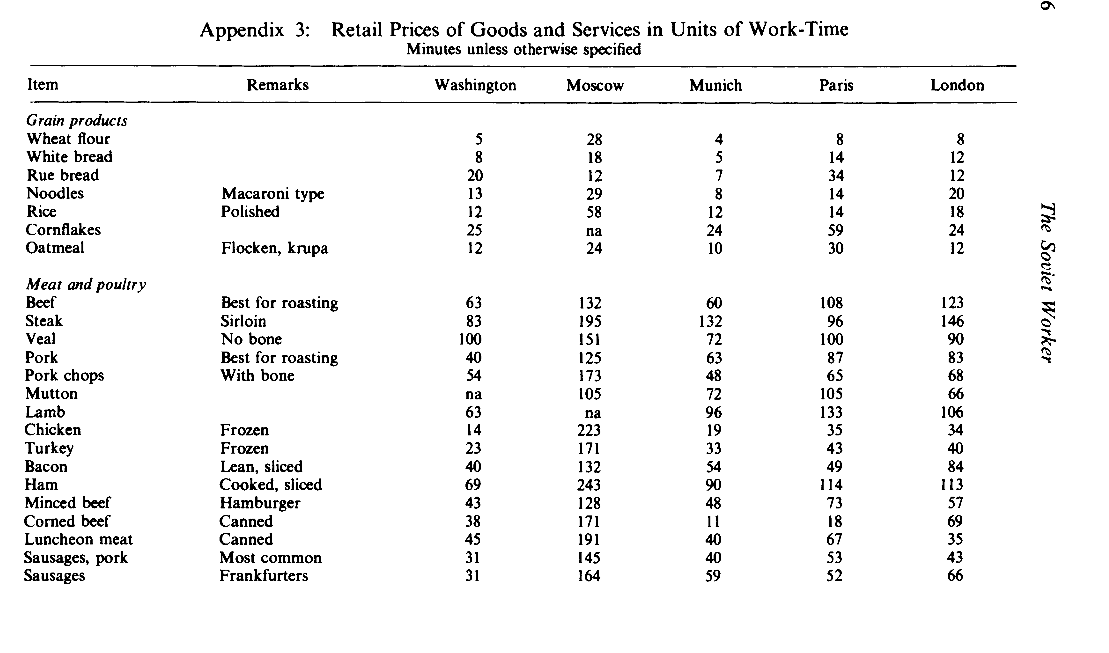
References
Anderson, B. A. (1987). Work Among Soviets of Retirement Age. National Council for Soviet and East European Research.
Bosch, G., Dawkins, P., & Michon, F. (1994). Times are changing: working time in 14 industrialised countries (Vol. 48). Geneva: International Institute for Labour Studies.
Bronson, D. W. (1968). Soviet experience with shortening the workweek. Industrial and Labor Relations Review, 391-399.
CIA (1961) An evaluation of the program for reducing the workweek in the USSR. Report.
Ellison, H. J., Johnson, B. P., & Raynes, E. A. (1984). The Quality of Life in the Soviet Union: A Conference Report. Kennan Institute for Advanced Russian Studies, Woodrow Wilson International Center for Scholars.
Lee, S., McCann, D., & Messenger, J. C. (2007). Working time around the world. Trends in working hours, laws and policies in a global comparative perspective (pdf). London and New York: Routledge.
Malle, S. (1990). Employment planning in the Soviet Union: continuity and change. Palgrave Macmillan.
Moskoff, W. (1984). Labour and leisure in the Soviet Union: the conflict between public and private decision-making in a planned economy. Macmillan Publishers Limited.
Porket, J. L. (1989). Work, employment and unemployment in the Soviet Union. Macmillan.
Schapiro, L., & Godson, J. (1981). The Soviet worker: illusions and realities. Macmillan.
Comments from WordPress
- The Soviet Union series | Nintil 2016-05-14T15:57:04Z
[…] The Soviet Union: Work and retirement […]
- Linky Friday #168: The Soviet Roc | Ordinary Times 2016-05-27T09:00:47Z
[…] Take a gander at work and retirement in the Soviet Union. Also, […]
- The Soviet Union: Achieving full employment | Nintil 2016-07-30T16:32:05Z
[…] in the Soviet context, and explain some aspects of their labour ‘market’ not covered in my previous post on this topic. As usual, this post covers the post-Stalin era. […]
- The Soviet Series: From farm to factory. Stalin’s Industrial Revolution | Nintil 2017-02-04T19:38:02Z
[…] had to be repressed and coerced into working as the State demanded. (I talked about this here and here) The problems the forced translation of labour from farm to factory caused with discipline are not […]